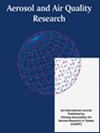Gaseous Pollutants and Particulate Matter in Ambient Air: First Field Experiment in an Urban Mediterranean Area (Nador, Morocco)
IF 2.5
4区 环境科学与生态学
Q3 ENVIRONMENTAL SCIENCES
引用次数: 0
Abstract
Mediterranean urban areas are reportedly affected by poor air quality due to numerous emission sources, as well as topography and meteorological conditions that facilitate the accumulation of pollution. This present study makes an initial attempt to assess the effect of gaseous pollutants (NO 2 , CO, and O 3 ) and particulate matter (PM 2.5 and PM 10 ) on the air quality of Nador city, which lies on the Mediterranean coast of Morocco. Three daily, short-term sampling campaigns were conducted between 2016 and 2018 in an urban area. The concentrations of PM 2.5 and PM 10 together with elemental compositions (up to 16 elements) and black carbon content were determined. The obtained data were characterized using descriptive analysis, correlation matrices, elemental enrichment factors (EFs), and elemental ratios. On average, the particulate matter and gaseous pollutant concentrations were below the national standard limits. Two categories of PM 2.5 and PM 10 sources, as derived from the EF investigation, were defined as soil/crustal (Ti, Al, Mn, Sr, K, Na, Ba, and V) and anthropogenic (Ni, Cr, Cu, Zn, and Pb). For black carbon, biomass burning was found to be the largest contributing source (3.1–8.4 µ g m –3 ), more so than fossil fuels (0.9–1.8 µ g m –3 ). This study highlights that an air quality management plan should be established for Nador city, including the implementation of a network of monitoring stations to help with identifying and controlling the activities causing air pollution.环境空气中的气态污染物和颗粒物:在地中海城市地区(摩洛哥纳多尔)的首次现场实验
据报告,地中海城市地区受到空气质量差的影响,原因是排放源众多,而且地形和气象条件也助长了污染的积累。本研究初步尝试评估气态污染物(NO 2、CO和O 3)和颗粒物(PM 2.5和PM 10)对摩洛哥地中海沿岸纳多尔市空气质量的影响。2016年至2018年期间,在城市地区进行了三次每日短期抽样活动。测定了pm2.5和pm10的浓度以及元素组成(多达16种元素)和黑碳含量。利用描述性分析、相关矩阵、元素富集因子(EFs)和元素比对所得数据进行了表征。颗粒物和气态污染物的平均浓度低于国家标准限值。根据EF的调查,PM 2.5和PM 10的两类来源被定义为土壤/地壳(Ti, Al, Mn, Sr, K, Na, Ba和V)和人为(Ni, Cr, Cu, Zn和Pb)。对于黑碳,生物质燃烧被发现是最大的贡献源(3.1-8.4µg m -3),超过化石燃料(0.9-1.8µg m -3)。本研究强调,应为纳多尔市制定空气质量管理计划,包括实施监测站网络,以帮助识别和控制造成空气污染的活动。
本文章由计算机程序翻译,如有差异,请以英文原文为准。
求助全文
约1分钟内获得全文
求助全文
来源期刊

Aerosol and Air Quality Research
ENVIRONMENTAL SCIENCES-
CiteScore
8.30
自引率
10.00%
发文量
163
审稿时长
3 months
期刊介绍:
The international journal of Aerosol and Air Quality Research (AAQR) covers all aspects of aerosol science and technology, atmospheric science and air quality related issues. It encompasses a multi-disciplinary field, including:
- Aerosol, air quality, atmospheric chemistry and global change;
- Air toxics (hazardous air pollutants (HAPs), persistent organic pollutants (POPs)) - Sources, control, transport and fate, human exposure;
- Nanoparticle and nanotechnology;
- Sources, combustion, thermal decomposition, emission, properties, behavior, formation, transport, deposition, measurement and analysis;
- Effects on the environments;
- Air quality and human health;
- Bioaerosols;
- Indoor air quality;
- Energy and air pollution;
- Pollution control technologies;
- Invention and improvement of sampling instruments and technologies;
- Optical/radiative properties and remote sensing;
- Carbon dioxide emission, capture, storage and utilization; novel methods for the reduction of carbon dioxide emission;
- Other topics related to aerosol and air quality.
 求助内容:
求助内容: 应助结果提醒方式:
应助结果提醒方式:


